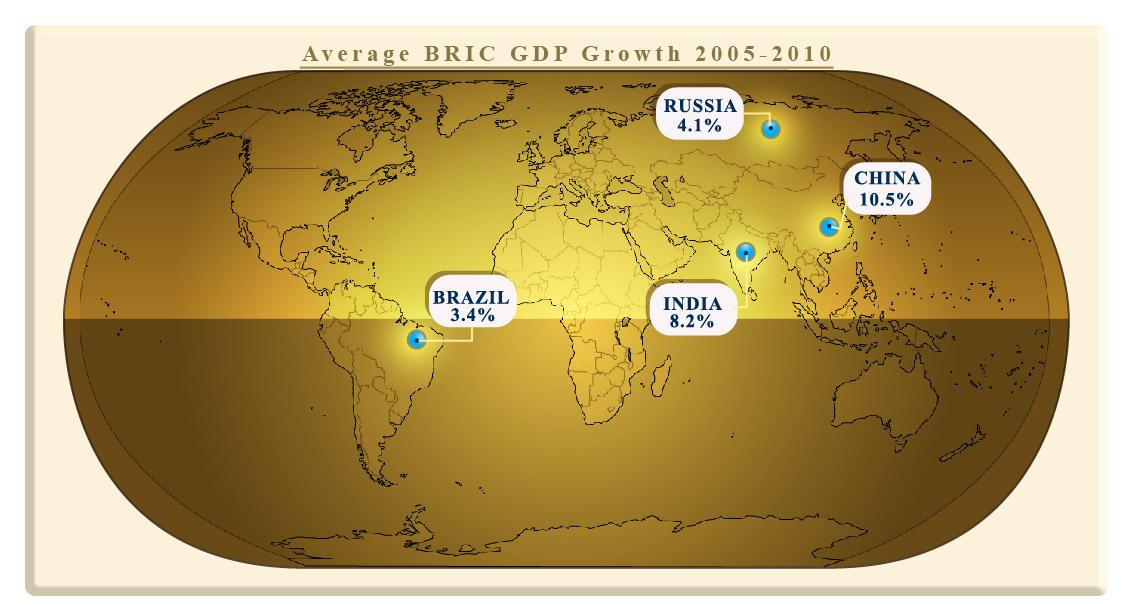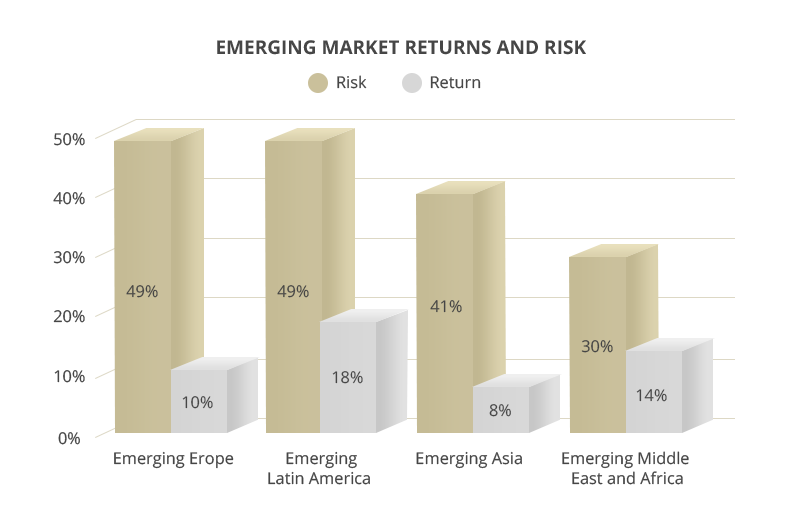StateTrust's global approach to emerging markets gives clients substantial coverage , while a local presence in each market ensures customer accessibility. Our trading capabilities allow us to buy either local currency or U.S. Dollar denominated securities. In addition, we trade equities, sovereign and global corporate debt bonds.
The ongoing process to expand capabilities in local and emerging markets and constantly investing in innovative products and technologies, give StateTrust's clients the opportunity to participate in a growing pool of investment opportunities. Likewise, the combination of local and global capacities enables our company to meet our customer's complex financial needs.
The term “emerging markets” was coined by the World Bank's International Finance Corporation in the early 1980s. The first emerging market indices appeared in 1987, and emerging markets became an asset class for portfolio allocation purposes.
Emerging Markets make up about the 70% of the world's population and 31% of its GDP. These markets attract $600 billions of foreign direct investment per year. By 2020, the five biggest emerging markets' share of world output will double to 16.1 percent from 7.8 in 1992. Many emerging countries have restructured their economies establishing market-oriented policies and offer a wealth of opportunities in trade, equity markets, technology transfers, and foreign direct investment.
A combination of factors depicts the Emerging Markets' social and economic profile:
- They are regional economic powerhouses with large populations, large resource bases, and large markets. Their economic performances influence the economies of countries under its orbit. For example, China is the main reason behind the large size of Asian Pacific emerging equity and fixed income markets.
- After the collapse of government-oriented economic systems, those countries embraced market economic structures in order to jump-start growth and social stability.
- They are the world's fastest growing economies and will become strong buyers of goods and services while competing for investment resources with industrialized countries.
Emerging market countries are experiencing rapid changes in their economic systems, political institutions, and financial markets, as well as rapid growth and industrialization. As a result, these emerging market economies offer less investment instruments, higher volatilities and in many cases limited opportunities to participate in their financial markets. Investors must be willing to endure above average volatilities and principal risk, but can be rewarded with higher portfolio returns.
The risk of an Emerging Market investment is higher than that of a developed market investment. There are three strong risk factors:
- Currency: Exchange rate fluctuations offer higher volatilities.
- Political and social: These factors are critical in the Emerging Market process of opening up its economy to the world.
- Investor restrictions: Investors must be willing to tolerate a higher volatility in their portfolio.
At StateTrust, we recommend participation in emerging market investments to clients with higher risk tolerance. Those clients with a high net worth profile and higher risk tolerances are encouraged to allocate a small % of their liquid net worth to Emerging Market bonds and stocks.

Since 2005, BRICs economies have lead global GDP growths. Thus, exposure to those fast growing economies is increasingly becoming an important component and asset allocation tool to global portfolios.
StateTrust client portfolios have exposure to this asset class, taking advantages of the BRIC's growth opportunities.
Below are some BRIC development projections:
- During this decade there will be a constant growth of the middle class.
- The middle class growth will fuel consumer demand.
- China and India will dominate infrastructure investments (new ports, railways, airports, irrigation systems).
The image below highlights the average last 5 years GDP growth rates for the BRIC economies. China and India posted the greatest GDP growth rates. The former has been Asia's fastest growing economy over the past 20 years.
The graphic below shows that while the possibility of good returns for emerging markets exists, they are often accompanied by much greater risk.

Source: StateTrust’s analysis of Morningstar data. Performance shown is not indicative of the performance of any specific investment. An investor cannot invest in an index, such as the one these graphs are based on. Past returns are no guarantee of future performance. These returns are based on historical information, from sources believed to be reliable, but accuracy cannot be guaranteed, and these returns can vary in future time periods.
- East Europe: Hungary, Bulgaria, Poland, Slovenia, Czech Republic, Slovakia, Russia, Ukraine, Armenia, Belarus.
- Africa: South Africa, Angola, Botswana, Zambia.
- Middle East: Jordan, Turkey, Pakistan, Israel, Lebanon, Qatar, Kuwait, Dubai.
- South and Central America: Brazil, Argentina, Peru, Mexico, Colombia, Chile, El Salvador, Guatemala, Panama, Costa Rica, Belize.
- Caribbean: Dominican Republic, Jamaica, Trinidad & Tobago.
- South East Asia: Indonesia, Malasya, Phillippines, Singapore, Thailand, Vietnam.
- South Asia: India, Pakistan.
- North East Asia: China, South Korea, and Taiwan.
- East Africa: Kenya, Uganda.
- West Africa: Ghana, Nigeria, Republic of Congo, and Senegal.
The graph below illustrates the hypothetical growth of $1,000 in different markets (among them Emerging-markets) over the period January 1, 2000 through December 31, 2018.

Performance shown is not indicative of the performance of any specific investment. An investor cannot invest in an index, such as the one these graphs are based on. Past returns are no guarantee of future performance. These returns are based on historical information, from sources believed to be reliable, but accuracy cannot be guaranteed, and these returns can vary in future time periods.